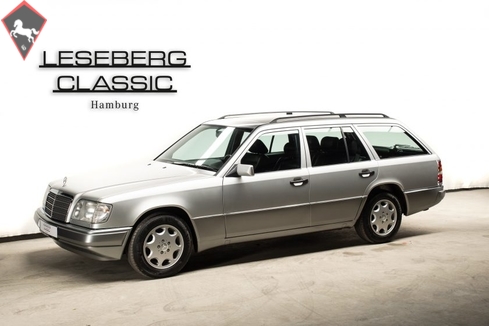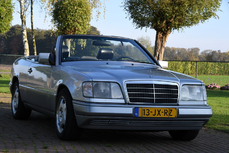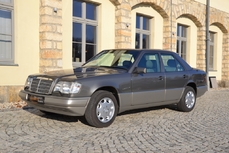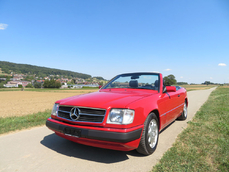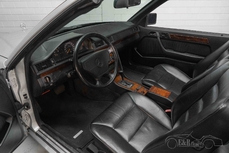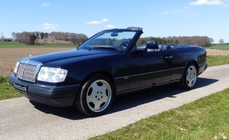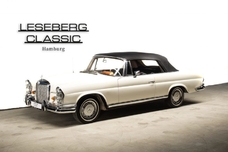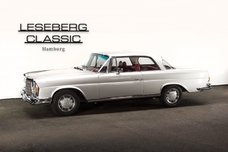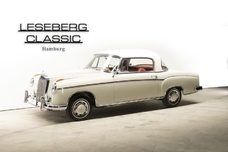Mercedes-Benz 300 w124 320 T 1994
General description :
Dass es so etwas überhaupt noch gibt: Ein 124er Kombi aus (fast) erster Hand, zugelassen ausschließlich in Deutschland, tolle Ausstattung, super Zustand und dann noch gut dokumentiert - das alles gepaart mit einer absolut vernünftigen Laufleistung von durchschnittlich etwa 5.500 Kilometer pro Jahr und einer schönen Farbkombination.
Der Wagen wurde am 7.1.1994 zugelassen auf eine Ärztin aus Krefeld, die erste Abmeldung erfolgte erst 2019. Danach war das Auto sehr kurz in Bottrop zugelassen, nun steht der Kombi bei uns.
Zu diesem E 320 T existiert die originale Bordmappe mit den Anleitungen, dem Händlerverzeichnis und auch dem Serviceheft. Die Ablieferungskontrolle fand am 7.11994 statt, darauf folgt ein Pflegedienst am 30.8.1994 bei 15.707 km, eine Wartung am 28.8.1995 bei 30.277 km, ein Service am 6.8.1996 bei 47.347, eine große Wartung am 1.10.1997 bei 60.010 km, ein Service am 9.4.1999 bei 74.998 km, eine Wartung am 4.12.2000 bei 84.686 km, ein Pflegedienst am 5.6. ... (nicht lesbar), wieder eine große Wartung am 23.9.2003 bei 116.347 km, ein Pflegedienst am 10.1.2008 bei 132.678 km, eine Wartung am 4.5.2015 bei 143.870 km - und nun 2019 eine Wartung bei etwa 145.000 km Gesamtlaufleistung durch uns.
Einige TÜV-Berichte sind erhalten und als echtes Highlight gibt es die Neuwagenbestellung vom 12.11.1993 ! Danach betrug der Neupreis DM 115.364,-.
In 2020 haben wir die Zylinderkopfdichtung erneuert.
Ausgestattet ist dieses T-Modell mit Getriebe Automatik 5-Gang, Schiebe-Hebe-Dach elektrisch in Stahlausführung, Sitzheizung der Vordersitze, Klimaanlage, CD-Wechsler 6fach, Vordersitz links elektrisch verstellbar, Vordersitz rechts elektrisch verstellbar, Lenkrad und Schalt-/Wählhebel in Leder, Schließanlage mit Infrarotfernbedienung, Radio MB Special, Antriebs-Schlupfregelung (ASR), Armlehne klappbar vorn, Außentemperaturanzeige, Fensterheber elektrisch 2-fach, getönten Scheiben, Abgasreinigungsanlage, Airbag Fahrer-/Beifahrerseite, Antenne automatisch, Doppelrollo, Einbruch- und Diebstahlwarnanlage (EDW), Innen- und Außenspiegel automatisch abblendend, Sonnenblenden mit beleuchtetem Spiegel, Wurzelnuss, Leichtmetallfelgen 8-Loch (mit frischen Reifen), etc.
Der Abschluß eines Gebrauchtwagengarantie Vertrages ist möglich. Über den Inhalt und die Kosten sprechen wir gern mit Ihnen !
https://www.leseberg-classic.de/fahrzeug/mercedes-benz-e-320-t-2439/
1994 Mercedes-Benz 300 w124 320 T is listed sold on ClassicDigest in Hamburg by Auto Dealer for €28500.
Car Facts
Car type : Car Make : Mercedes-Benz Model : 300 w124 Model Version : 320 T Engine size : 3.2 Model Year : 1994 Location : Hamburg
Sold
Seller Information
Sold
People who viewed this Mercedes-Benz 300 w124 also viewed similar Mercedes-Benz listed at ClassicDigest
Other cars listed for sale by this dealer
About Mercedes-Benz
In the annals of automotive history, the journey of Mercedes-Benz is a tale that unfolds with the ingenuity of its founding pioneers. In the year 1886, Karl Benz crafted the Benz Patent Motorwagen, a creation that would go down in history as the world's inaugural automobile. Unbeknownst to him, this moment marked the genesis of what would evolve into the most illustrious premium car manufacturer globally. The financial underpinning of this pioneering venture, interestingly, was provided by Karl Benz's wife, Bertha Benz, demonstrating a remarkable partnership that would set the tone for Mercedes-Benz's legacy.A parallel narrative emerged not far away, as Daimler-Motoren-Gesellschaft, founded by Gottlieb Daimler and Wilhelm Maybach, entered the scene. In 1901, they unveiled their automobile under the now-famous moniker "Mercedes," meaning "godsend" in Spanish. This name was bestowed upon the car at the behest of Emil Jellinek's daughter, the distributor for Daimler-Motoren-Gesellschaft. The wheels of innovation were set in motion.
Fast forward to 1926, a pivotal year that witnessed the merger of Daimler with Benz & Cie., culminating in the birth of Daimler-Benz. The amalgamation saw the adoption of "Mercedes-Benz" as the distinguished trademark for their automobiles, fusing the legacies of two visionary entities into one.
Contrary to perceptions of conservatism, the trajectory of Daimler-Benz unfolds as a chronicle of industry firsts. From the introduction of the honeycomb radiator to the float carburetor, and the pioneering implementation of four-wheel brakes in 1924, Daimler-Benz consistently pushed the boundaries of automotive innovation. The diesel-powered Mercedes-Benz 260 D in 1936 marked the inception of diesel engines in passenger cars. The iconic Mercedes-Benz 300SL Gullwing made history as the first car with direct fuel injection, albeit the Gutbrod's tiny 2-stroke engine can claim precedence.
Safety innovations became a hallmark, with Béla Barényi's patented safety cell design in the "Ponton"-models in 1951, featuring front and rear crumple zones. The W116 450SEL 6.9 saw the introduction of the Anti-Lock Brake system (ABS), another pioneering safety feature. From the first production airbags and beyond, the legacy of "firsts" continued to be etched into the fabric of Daimler-Benz.
Over its centennial journey, Mercedes-Benz has not merely produced cars but has sculpted automotive icons. The SSKL, 710 SSK Trossi Roadster, 770K Grosser, 540K Spezial Roadster, 300SL Gullwing, w100 600 Pullman, w111 280SE 3.5 Flachkühler, w113 230SL Pagoda, w109 300 SEL 6.3, and w201 2.3-16 Cosworth stand testament to the brand's commitment to engineering excellence.
The roaring Silver Arrows, or "Silberpfeile," including the W 25, W 125, W154, W165, and W196, created a legacy of dominance on the racetrack. These machines were not merely cars; they were expressions of precision, speed, and an indomitable spirit that left their competitors in the dust.
As Mercedes-Benz marches into the future, it does so not just as an automaker but as a custodian of a legacy, a torchbearer of innovation, and a beacon of automotive excellence. The road ahead is sure to witness the continued fusion of cutting-edge technology, timeless design, and an unwavering commitment to setting new standards in the world of automobiles.
One luminary figure who left an indelible mark was Béla Barényi, often heralded as the "father of passive safety" for his pioneering work in safety engineering. His patented safety cell design, featuring front and rear crumple zones, became a hallmark of Mercedes-Benz's commitment to occupant safety, setting new standards that reverberated throughout the automotive world.
Moving through the chronicles, the collaborative genius of Wilhelm Maybach, alongside Gottlieb Daimler, laid the foundation for Daimler-Motoren-Gesellschaft. Their innovations not only birthed the first Mercedes but established a culture of relentless pursuit of technological excellence that remains integral to Mercedes-Benz's DNA.
In the post-merger era of 1926, Ferdinand Porsche emerged as a prominent figure within Mercedes-Benz. His work on the Mercedes-Benz S-Type, a supercharged race car, garnered acclaim and set the stage for a legacy that extended far beyond the marque. Porsche's impact would later extend to his eponymous company, but his influence at Mercedes-Benz during those formative years was pivotal.
As the 20th century progressed, the legendary Rudolf Uhlenhaut emerged as a key figure. Uhlenhaut, an accomplished engineer and the driving force behind the iconic Silver Arrows, played a crucial role in Mercedes-Benz's dominance in motorsports. His engineering prowess and attention to detail were instrumental in creating some of the most formidable racing cars of the era.
In the latter half of the century, figures like Bruno Sacco, the head of design at Mercedes-Benz from 1975 to 1999, left an indelible imprint on the brand's aesthetic identity. Sacco's design philosophy, characterized by clean lines and timeless elegance, shaped iconic models like the W126 S-Class and the W201 190E, solidifying Mercedes-Benz's reputation for luxury and sophistication.
The narrative would be incomplete without acknowledging the contributions of engineers like Hans Scherenberg, whose leadership in the 1970s ushered in a new era of technological innovation at Mercedes-Benz. Scherenberg's tenure saw the development of groundbreaking technologies, including the Anti-Lock Brake system (ABS) and the introduction of airbags in production cars.
